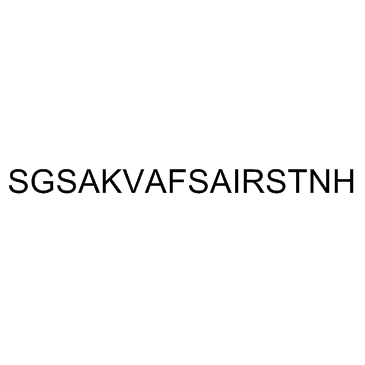94071-26-8
| Name | cerebellin |
|---|---|
| Synonyms |
SGSAKVAFSAIRSTNH
Nh2-Ser-Gly-Ser-Ala-Lys-Val-Ala-Phe-Ser-Ala-Ile-Arg-Ser-Thr-Asn-His-OH H-SER-GLY-SER-ALA-LYS-VAL-ALA-PHE-SER-ALA-ILE-ARG-SER-THR-ASN-HIS-OH Cerebellin (rat) SER-GLY-SER-ALA-LYS-VAL-ALA-PHE-SER-ALA-ILE-ARG-SER-THR-ASN-HIS |
| Description | Cerebellin is a neuromodulatory peptide widely distributed in the central nervous system. |
|---|---|
| Related Catalog | |
| In Vitro | Cerebellin concentration-dependently (from 1 to 100 nM) increases norepinephrine (but not epinephrine) and cyclic-AMP production by adrenomedullary tissue in vitro[1]. |
| In Vivo | Cerebellin potently stimulates norepinephrine release by rat adrenal medulla, acting through adenylate-cyclase/PKA-coupled receptors, and enhances adrenocortical steroid secretion in vivo (i.e. when the integrity of adrenal gland is preserved) through an indirect paracrine mechanism involving the release of medullary catecholamines[1]. Cerebellin reduces plasma insulin levels in rats after 1 and 2 h. Cerebellin decreases insulin secretion from isolated rat pancreatic islets at high (11 mM), but not at low (3.33 mM) glucose concentration. Cerebellin inhibits stimulated insulin secretion from clonal rat insulinoma (INS-1) cells, reduces forskolin-induced production of cAMP and intracellular calcium concentration[2]. |
| Kinase Assay | Some adrenomedullary samples are incubated with 10 μM H89, U-73122 or calphostin-C alone or in the presence of 0.1 μM cerebellin. When cyclic-AMP production is assayed, 100 μM 3-isobutyl-1-methylxanthine is added to prevent cyclic-AMP metabolism by phosphodiesterases. Incubation is carried out for 60 min (aldosterone or corticosterone production), 30 min (catecholamine production) or 10 min (cyclic-AMP production) in a shaking bath at 37°C in an atmosphere of 95% air -5% CO2. At the end of the experiments, the incubation tubes are centrifuged at 4°C, and media are collected and kept frozen at -80°C[1]. |
| Animal Admin | Rats[2] Adult female Wistar rats (180–190 g body weight, 8–12 weeks of age) are injected daily with 0.2 mL of 0.9% NaCl (s.c.) for 14 days. On day 15, animals receive s.c. injections of 0.2 mL of 0.9% NaCl (control groups), while experimental groups are treated with 0.5 or 1.5 nmol/100 g body weight Cerebellin0.5 or 1.5 nmol/100 g body weight Cerebellin. Rats are decapitated 60 or 120 min after injection. Blood is collected into ice-cold tubes containing EDTA (1 mg/mL) and analyzed for the concentration of glucose. Plasma is separated and stored at −80 °C for the determination of the insulin and glucagon concentration[2]. |
| References |
| Molecular Formula | C69H113N23O23 |
|---|---|
| Molecular Weight | 1632.78000 |
| Exact Mass | 1631.84000 |
| PSA | 760.66000 |
| Storage condition | 2-8℃ |
